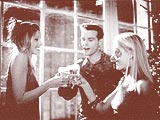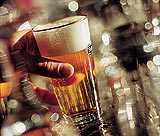 The
glorious thing about beer is that it comes in all styles, colours, tastes and
aromas. Although the raw materials are similar, the end results of brewing cover
the complete taste spectrum.
The
glorious thing about beer is that it comes in all styles, colours, tastes and
aromas. Although the raw materials are similar, the end results of brewing cover
the complete taste spectrum.Beer Styles & Rituals
 The
glorious thing about beer is that it comes in all styles, colours, tastes and
aromas. Although the raw materials are similar, the end results of brewing cover
the complete taste spectrum.
The
glorious thing about beer is that it comes in all styles, colours, tastes and
aromas. Although the raw materials are similar, the end results of brewing cover
the complete taste spectrum.
An A-Z run through beer styles will take you from Aarschots ale all the way to Zwickelbier and if you have time to sample every one in between then you must have the patience of a saint.
And it certainly is not wrong to mention beer in the same breath as religion an extra strong beer was recently blessed in a chapel positioned in the brewery of its origin. Apparently, the service was conducted with great dignity which passed on the blessing to all who produced it and those that might drink it in the future.
The ceremony gives an indication of the cultural importance of beer as well as an insight to the range of styles that can inspire emotions and devotions. The biggest influence on beer style is the human senses. Slight shifts of tastes can make a beer vastly different. The fact that there are tens of thousands of different beers around the world demonstrates that personal preference can alter from one drinker to the next even if they live in the same street.
Green Machine
 There
is a beer to suit all tastes, from chocolate to sharp spices. There is even
a special green beer that makes an appearance on St. Patrick’s Day; Ireland’s
saints day. Brewers can pride themselves on catering for everyone as non-alcoholic
beers are now readily available and are very drinkable.
There
is a beer to suit all tastes, from chocolate to sharp spices. There is even
a special green beer that makes an appearance on St. Patrick’s Day; Ireland’s
saints day. Brewers can pride themselves on catering for everyone as non-alcoholic
beers are now readily available and are very drinkable.
There are four main types of beer – ales, lagers, hybrids and speciality beers. These are then broken down into different groupings and the list of individual beers would probably stretch across an ocean. There are 15,000 styles of beer with at least 40,000 different makes. The look, aroma and taste range from white beer to black beer and from a light, fruity aroma to the rich smell of malt.
A white beer, such as Wieckse Witte has coriander and smells of fruit; George Killian’s is red-coloured, rich, creamy and from a 135-year-old Irish recipe. Ale is the elder brother of the beer family, having been around since the dawn of civilisation. Lagers are the new kids on the block with only around 500 years to their history. Hybrid beers are combinations of the two styles, where the brewing process is manipulated for different tastes, and speciality beers use unusual ingredients to produce almost any flavour.
Ale is produced by a process called "top-fermentation" which the beer is aged for a few days before serving. It has a distinct flavour of hops and has a darker appearance than lager, which is "bottom-fermented" and aged for up to three months. It was invented by Bavarian monks who discovered they could produce a clearer brew by storing it during the summer in cold caves. The word comes from the German lagern, which means to store.
But the religious orders did not simply concentrate on lagers. Abbey Ales are a strong and recognised style and are traditionally strong ales sold in bottles.
Sweet Sensations
The uniqueness of each beer style comes from the mineral
content of the water and the properties of the ingredients. If you consider
that hops or barley grown in neighbouring fields can give subtle variations,
then it is easy to realise the breadth of choice in the beer world.
Ales, although traditionally associated with Great
Britain, are brewed around the world. They include bitter, mild, pale ales,
brown ales, old ales and barley wine. Lagers range from light, delicate pilsner
beers to dark, aromatic bocks.
Each provides a huge sweep of tastes that can register on the tongue's 10,000
taste buds. Receptors pick up the information and deliver it to the brain. It
is not the sort of detail considered when drinking, but the front of the tongue
is better at picking sweet sensations while further back is the territory for
the bitter scale.
The six characteristics that determine beer style are; fermentation, colour, strength, taste, origin, season. Each of the key ingredients of hops, barley malt, yeast and water dictate the final result. There is a great art in brewing a beer but how it is served has a huge bearing on its success. The style and shape of a beer glass exerts an influence on the flavour. A beer served in a tall, thin glass can taste quite different if presented in a wider and fatter glass. Some shapes encourage a foam head on a beer which can enhance certain beers whilst acting as a physical barrier to others.
Heineken has performed extensive research into how each beer's properties react in different glasses. It shows that the shape of the glass does have an influence on a beer's characteristics. The rate the beer is warmed once it is in the glass, the rate at which a beer loses its carbon dioxide saturation and the influence the shape has on the behaviour of the beer head are important factors in the final taste. Some components of a beer's taste, for instance, can only be detected when the thickness of the head falls below 0.5 cms.
Rather like the wine trade, different beers do demand their own style of glass. You would not pour champagne into a wide-open red wine glass because its appeal would soon fizzle out. Similarly, certain lagers should always be served in tall cylindrical shaped glasses. Strong, full-flavour Abbey beers are better in broad chalice-shaped glasses that let their aromatic profile flood out of the surface. Tall, straight cylindrical glasses are normally intended for beers with a cleaner flavour. Glasses made to a tulip or thistle design can delay the rate at which a beer warms once it is poured and the narrowing of the neck helps more bubbles form and therefore a more frothy head.
A good brewer will strive to discover the best possible glass to show off a beer’s true qualities and then encourage drinkers to use that style. Often, brand names are printed or engraved on the side of the glass just to make sure people get the message. But a dirty glass and sloppy presentation can ruin the effect. Heineken views what happens in the glass as a vital part of the beer chain and organises beer drawing and serving contests to encourage good practice.